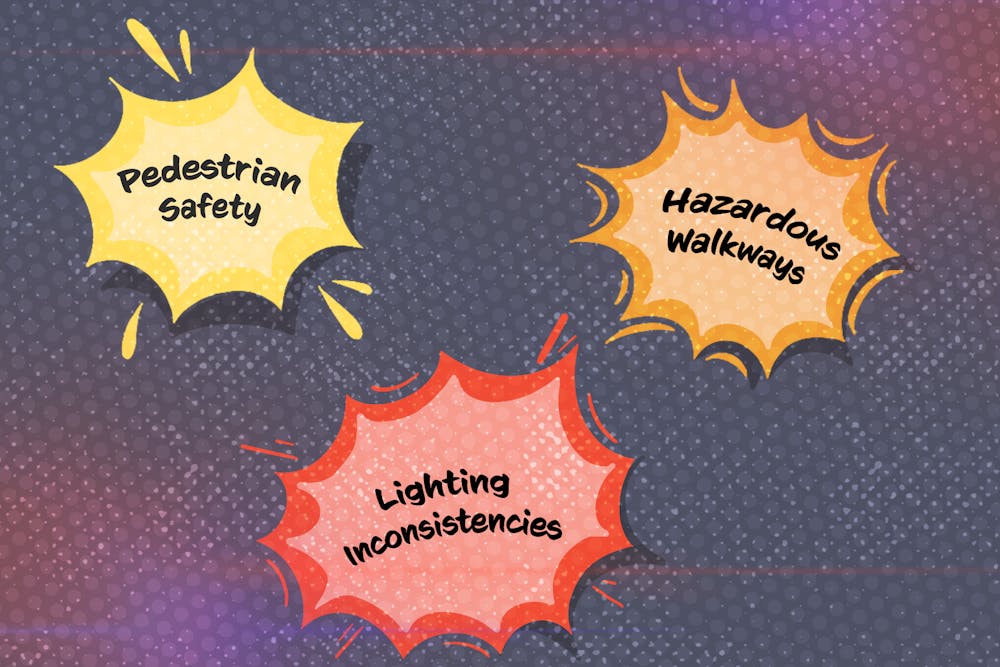Students and other USC workers found issues such as inadequate lighting, overgrown landscaping, hazardous walkways and maintenance and housing concerns during a safety walk in October where participants surveyed the campus for potential dangers.
Each semester, Student Government partners with the USC Police Department to host a safety walk where USC students, faculty and staff walk around campus to look for and address potential safety and mobility issues.
The fall 2024 Safety Walk, held on Oct. 22 at 7:30 pm, had about 50 participants. Representatives from Student Government, USCPD, the Facilities Department, the Residence Hall Association and Parking and Transportation Services were available to speak with participants about any questions and concerns they might have about campus safety, such as feeling unsafe while walking at night.
The purpose of the safety walks are to give the USC community a chance to be transparent with USCPD and the Facilities Department and show them areas on campus that have issues needing to be fixed, said Student Body Vice President Courtney Tkacs.
Participants broke into four groups, each consisting of two or three representatives from USCPD and Facilities. Each group was assigned to a specific area of campus.
Tkacs said her group, along with most other groups, noticed issues such as some lights being out and smaller poles, located close to the road, being loose. They found these loose poles on the bridge leading to Campus Village. She said there were also some cracks in the concrete that could potentially be a safety hazard for both pedestrians and cyclists.
In certain areas, the lighting systems were inconsistent, she said. Some lights are controlled by timers, while others adjust based on how dark it is. But sometimes the two systems do not work together. Participants also identified spots where additional lights could improve safety, especially where there were gaps in coverage.
"I definitely saw some lighting concerns and some areas where there were no lighting areas in the bikes. I really wanted to advocate to increase the lighting around bike racks because I know that's a high theft area," Tkacs said. "Over by Campus Village, there were some areas where the sidewalk was getting broken down because of the amount of drivers that typically are there, whether it's Uber or Lyft."
Participants walk the entire campus to identify locations in need of extra assistance, Student Body President Patton Byars said.
"I was on the Horseshoe and my group looked at places that were out of lights, areas people might not want to walk at night, places that might not meet ADA requirements and things like that," Byars said. "We're just trying to make a safer campus."
Byars said that during the last safety walk, which took place April 17, 30 to 40 lighting issues were pointed out on campus, most of which have since been resolved.
USCPD Capt. Eric Grabski said the walk used to occur annually until Student Government and USCPD decided to hold one each semester one in the spring and one in the fall.
"It's really a great initiative, not just for USCPD and Student Government but for other partners that both of our groups have," Grabski said.
All the concerns raised during the walk are compiled and sent to the appropriate fields for action, such as the Facilities Department for maintenance issues or the Housing Department for housing-related concerns, Grabski said.
Tkacs said that concerns raised during the walk are entered into a system by USCPD and Facilities, flagged, and get worked on within a couple of weeks.
"It sometimes becomes very tricky to determine whose jurisdiction concerns fall under — whether it's USCPD, Housing or Columbia. Having Housing there greatly benefitted the effectiveness that is going on. They started distributing the tasks. Facilities showed me the system they put (concerns) into and they showed me that there's a place where you can check if it's updated," Tkacs said.
Grabski said the safety walks are impactful because they unite USC campus partners, including students, to collaboratively and practically address safety concerns.
"Sometimes students, or even some of the staff members that participate bring issues that they've witnessed, not on the walk, but in their regular life on campus. So that's also something that's noted," Grabski said.
Safety is not solely the police's responsibility but something that everyone shares, Grabski said. While they provide resources, support, education and events like safety walks, it makes a difference when the community comes together, he said.
"(Safety Walks) help the community to have a better understanding and more focused, observational skills for safety," Grabski said. "Part of that is sending those (issues) to the city of Columbia or to whatever unit."

Tkacs said another initiative that has been in the works is a safety run.
"The safety run has a different motivation behind it, but it's to give students a safe running spot and to show them that they can run on campus without having to technically leave campus," Tkacs said. "I've been working with a local Columbia running group to map out a campus route and plan to involve groups like Healthy Celebrations and Carolina Girls to explore new routes."
Byars said he also wants to do a safety walk that focuses more on pedestrian safety.
"For the pedestrian safety walk, I want to walk with law enforcement in areas with limited visibility, where drivers may not notice pedestrians or students may not see cars coming," Byars said. "There have been a lot of unfortunate accidents because either the student or the driver isn't paying attention when crossing the street. Hopefully, we can do both walks throughout the year."
The next safety walk is scheduled to take place on April 17 from 6:30 p.m. to 8:30 p.m.

